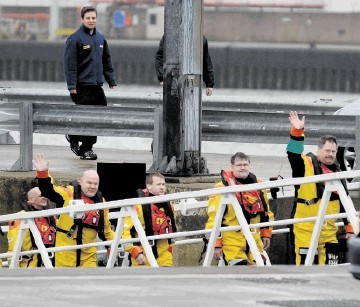
A textbook ditching was followed by a textbook rescue as emergency helicopters and an RNLI lifeboat plucked the Bond pilots and their passengers to safety.
Last night a union boss called the delicate sea landing a “terrific piece of airmanship” which prevented another offshore tragedy.
And rescue bosses said the multi-agency operation to pull the men from the water was flawless.
Fourteen people – 12 passengers and two crew – were on board the aircraft when it came down 25 miles off the coast of Aberdeen shortly after midday.
The men had been told by the pilot just moments earlier that they were making an emergency landing.
However, the men did not panic and calmly climbed aboard a liferaft – where RNLI crews from Aberdeen found them in “good spirits”.
Lifeboat operations manager Maitland Miller said: “They were all upbeat – but they were pleased to see us. The sea was OK for a lifeboat, but the guys in the liferaft were getting thrown around a bit.”
Eight men were taken on to the boat, before three of them were winched into a rescue helicopter – alongside the other six men.
At around 1.50pm the first six casualties, including one member of the helicopter crew, touched down at Aberdeen Royal Infirmary’s helipad.
Crowds of people gathered outside in the rain to see them return safely home.
The men were quickly ushered from Shetland Coastguard’s rescue helicopter into an ambulance which was awaiting their arrival.
Around 20 minutes later the RAF helicopter from Boulmer arrived at the hospital with three more passengers.
The tired and shaken offshore workers gave the helicopter pilots a grateful wave as they boarded the ambulance.
The five remaining workers – on the lifeboat – returned to dry land approximately 30 minutes later.
The men appeared to be in good spirits as they disembarked, and two waved as they made their way to the RNLI headquarters on Waterloo Quay.
There they received a medical check-up as a precaution, before getting into a taxi around an hour later. They were taken to the Thistle Aberdeen Airport hotel at Dyce – where there was a heavy police presence – to be debriefed.
Around 30 minutes later, the men who had been airlifted onshore also arrived at the hotel, after receiving medical attention at ARI.
Around 5.30pm, members of the men’s families began arriving at the scene, to take the rescued workers home.
Mr Miller added: “Fortunately no one was hurt and no one required first aid. From our point of view what we did was a textbook operation from the time we launched until we came back.”
Jim McAuslan, general secretary of pilots’ union Balpa, said the crew had done fantastically to land the helicopter in rough seas.
“This looks like a terrific piece of airmanship from very skilled pilots,” he said.
“A helicopter ditching is one of the most difficult manoeuvres in commercial aviation and yet reports indicate that every passenger and crew member on board has been winched to safety.
“So we pay the utmost tribute to the pilots involved in the incident and, of course, the search-and-rescue pilots who came to the passengers’ and crew’s aid.”
Jim Ferguson, an aviation writer, said if the pilots had not taken the helicopter down, all 14 on board could have been in mortal danger.
He said: “As far as I’m aware, the pilots noticed the oil pressure warning light had come on, they’ve sent out a mayday, pulled out the liferaft and paddled into the sunset. They followed the right procedures.
“The pilots could have continued and hoped for the best, but that would have been the completely wrong thing to do.
“You simply cannot mess around with oil pressure, the consequences would be devastating,” added Mr Ferguson.